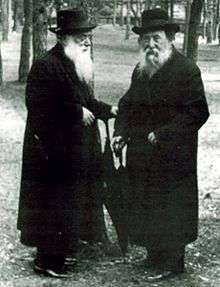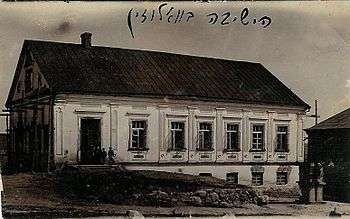Shimon Shkop
| Rabbi Shimon Yehuda Hakohen Shkop | |
|---|---|
 Rabbi Shimon Shkop, left, conversing with Rabbi Chaim Ozer Grodzinski | |
| Born |
1860 Torez |
| Died |
October 22, 1939 (ט חשון) Grodno |
| Occupation | Rosh Yeshiva of Telz and Grodna |
Shimon Yehuda Hakohen Shkop (Hebrew: שמעון שקופ; 1860 – October 22, 1939) was a rosh yeshiva ("dean") in the Yeshiva Shaar Hatorah and in the Telshe yeshiva and a renowned Talmudic scholar. He was born in Torez in 1860. At the age of twelve he went to study in the Mir yeshiva, and at fifteen he went to Volozhin yeshiva where he studied six years. His teachers were the Netziv and Rabbi Chaim Soloveitchik, with whom he was very close.
Telz
Rabbi Shkop married a niece of Rabbi Eliezer Gordon and in 1885 was appointed to the Telz Yeshiva, where he remained for 18 years until 1903. While there, he developed a system of Talmudic study which combined the logical analysis and penetrating insights of Rabbi Chaim Brisker with the simplicity and clarity of Rabbi Naphtali Zevi Yehudah Berlin (the Netziv) and which became known as the "Telz way of learning".
In 1903, he was appointed Rabbi of Moltsh, and in 1907 of Bransk. A famous pupil of his in Moltsh was Rabbi Yechezkel Sarna who studied under him for a year in 1906, before leaving to the Slabodka yeshiva when Rabbi Shkop himself left. During World War I, the communal leaders urged him to leave before the Germans arrived, but he refused and stayed with his community.
Grodno
Between 1920 and 1939, at the request of Rabbi Chaim Ozer Grodzinski, he succeeded Rabbi Alter Shmuelevitz as Rosh Yeshiva of the renowned Sha'ar HaTorah in Grodno. He raised the level of the institution and transformed it into one of the finest yeshivos in Poland and beyond. Hundreds of young men flocked there from near and far. For many years, Rabbi Zelik Epstein, who was married to a granddaughter of Rabbi Shkop, has headed a successor institution in Queens, known as Yeshivath Shaar Hatorah - Grodno. It was there that he taught Rabbi Dovid Lifshitz, the Suvalker Rav.
As a young man of eighteen, Rabbi Chaim Shmuelevitz was invited by Rabbi Shimon to give the third level lecture in the Yeshivah Ketanah in Grodno. At the age of 22, he headed a group of students who transferred from Grodno to Mir. However, his four years in Grodno with Rabbi Shimon had a profound influence on his approach to Talmudic analysis.
Yeshiva University
In 1928, Rabbi Shkop traveled to the United States in order to raise much needed funds for the Yeshiva. After delivering a lecture at Yeshiva University, he eventually acceded to Rabbi Bernard (Dov) Revel's invitation to serve as a Rosh Yeshiva of Rabbeinu Yitzchak Elchanan (RIETS) in New York. In his absence from Poland, he was greatly missed by Rabbis Yisrael Meir Kagan and Chaim Ozer Grodzinski, who pleaded with him to return. He also received a scathing letter from Rav Yeruchom Levovitz, the mashgiach of Mir, which, according to an eyewitness, he ignored. He left in 1929. Why is not clear. Many say for family reasons, Rabbi Shkop chose to return to Europe in the fall of 1929. This was the alleged inability of REITS to get a visa for his son and family to come to the USA. His grandson by marriage, Rabbi Z. Epstine has stated that this is the reason for his leaving. However, according to students at the time, his unhappiness with the dual curriculum of REITS (secular and religious) played a role in his leaving.
Character and personality
Rabbi Shkop had a winning personality. He was an active member of the Moetzes Gedolei HaTorah of the Agudas Yisroel. Many of his students attained distinction, among them Rabbis Elchonon Wasserman of Baronovitch, Yisrael Zev Gustman, Yosef Shlomo Kahaneman of Ponevezh and Isser Yehuda Unterman, a future Israeli Chief Rabbi. Dayan Michoel Fisher of London was also a pupil of Rabbi Shkop.
Rabbi Shkop formed close bonds with [the younger] Rabbi Yehuda Zev Segal, the future Manchester Rosh Yeshiva. He would sometimes come to England to raise funds for his yeshiva, and Rabbi Segal took advantage of these opportunities to serve as his attendant, spending one vacation at Rabbi Shimon's summer resort, studying with him and accompanying him on his walks.
Major works
He published his classic essay two volume book Sha'arei Yosher (The Gates of Honesty) in 1925 and Ma'arekhet ha-Kinyanim in 1936. Novellas on the Talmud tractates Bava Kamma, Bava Metzia, and Bava Basra were published posthumously in 1947 with a preface by his son, and on Nedarim, Gittin, and Kiddushin in 1952, and on Yevamos and Ketuvot in 1957. Rabbi Shkop's Talmudic novellas are still studied in yeshivos throughout the world today.
Sha'arei Yosher is largely concerned with the intellectual principles by which the law is established, rather than with concrete laws, and is stylistically similar to the Shev Shema'tata of Aryeh Leib HaCohen Heller, on which it was partly based.
Death
As the Russian army was about to enter Grodno during World War II, he ordered his students to flee to Vilna and he himself died two days later on the 9th of Cheshvan 5700 (1939) in Grodno. Including his death, the Jewish people lost three Rabbis and Torah giants in 10 months: Harav Shimon Shkop, Harav Boruch Ber Leibowitz of Kamenitz and Harav Chaim Ozer Grodzinski. He is buried in the Jewish cemetery in the Zaniemanski Forshtat section of Grodno.
